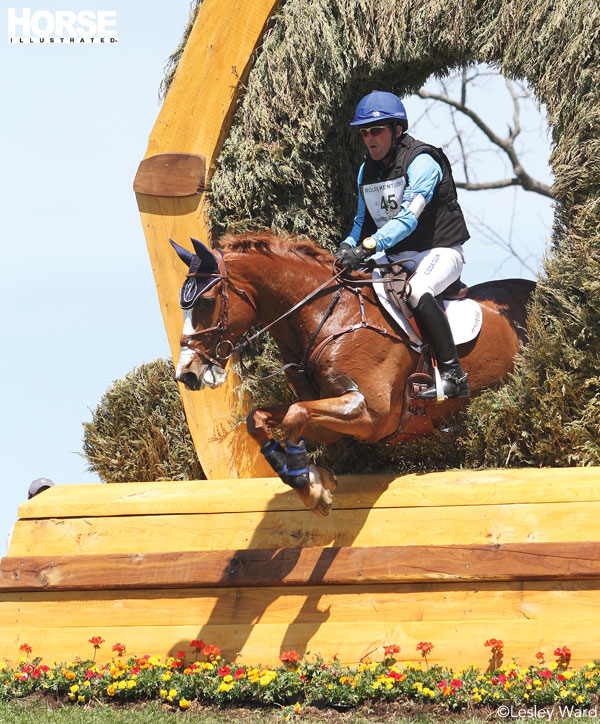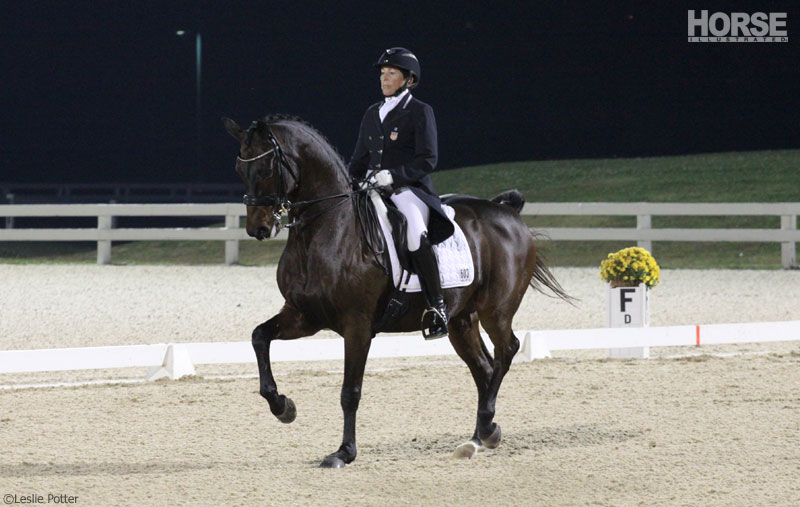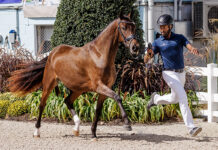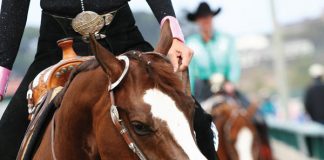 Phillip Dutton and Mr. Medicott |
It’s no secret many top riders prefer the competitive edge a hot horse can give. So how do they make it work, and how do those tips translate for the rest of us?
Extra Work Ethic
A world-class event rider, Phillip Dutton is no stranger to hot rides. While amped-up Thoroughbred-types are often associated with the eventing world, Dutton explains that not only can hot types come in any breed, but there are also variations within hot horses; every horse is an individual. Hot types, he notes, are often much more aware of their surroundings and the activities around them, causing them to be a little bit more on edge.
This heightened sensitivity can pay off, points out Dutton, who helped bring home two Olympic gold medals for the Australian eventing team in 1996 and 2000. He has also represented his adoptive country, the United States, at the Olympics in 2008 and 2012.
“In a lot of cases, hot horses try quite hard,” says Dutton. “They want to do their job well, and can get nervous while trying a little bit too hard. Often once you get them to settle, you do have a good horse on your hands.”
Grand Prix dressage rider Shelly Francis, a member of the 1998 World Equestrian Games U.S. team, echoes these sentiments. “Most of the horses that I’ve trained for myself to compete have been on the hot side,” she says. “Some people don’t like that, but for me it’s a good thing; I like them that way because they offer you a little more energy on their own. I find with hot horses that if you take the time to teach them what you want, they use that hotness toward being willing.”
Good Horsekeeping
As with any horse, managing the horse as an individual is key. For many hot horses, pasture turnout, which both Francis and Dutton recommend, is a stress-reducer.
“I really like to let my horses have some turnout every morning to have a good roll and a little play in the paddock,” says Francis. “All of the schooling and training is disciplined; they have to do what you want. With turnout, they have that spell of time in which they can feel free. If they are the type that gets too crazy, I turn them out after they’ve been ridden. All of my competition horses get turned out. I really believe it helps their mental stability.”
Hand-walking, especially away from home, is another option for getting out and about, reducing over-eagerness. Hacking outside of the arena, whether in addition to regular work or on rest days, benefits both body and mind.
While you need to allocate time for turnout, hacking and hand-grazing, you also need to consider that hot horses often require additional work time. “Hot horses can be extra work—not just at shows, but at home as well,” says Dutton. “You’ve got to have time on your hands; you can’t be in a rush. This isn’t the kind of horse you can get on and say, ‘Well, I only have 20 minutes to ride.’ You have to be able to organize your day so that you have enough time, because with a lot of these hot horses, if you rush them, they get worse. Some days you get on and everything’s OK, while other days you get on and you’re going to have to take some time to get them where you want to be. Giving the horse the time he needs is probably the most important element.”
Dutton goes on to explain that every horse is different, so your approach should be equally customized. Some horses enjoy a session on the longe to blow off a little steam, while others need a long, easy warm-up. “Try to find what settles the horse down so he’s at his best, and not tense and worried,” he says.
Another consideration is your horse’s diet (see “Feeding the Hot Horse”). “Evaluate your feed,” says Dutton. “A lot of times, you need to try to get the horse his calories in a way that is calming, like feeding healthy oils and staying away from grain-based feed. Often, grain can really ‘hot’ a horse up. You want a feed that gives enough nutrition and energy without hotting him up.”
Easy Does It
While good training is part of any horse’s foundation, you may have to step up your game a bit with a hot horse. “In some ways you probably have to train a hot horse better than you would a quieter horse,” says Dutton. “They really have to rely on you, your direction, and your aids. Understand before you get on that you’re going to be the quiet, sensible one, and try to instill that in your horse.”

Shelly Francis riding Doktor
Pushing ahead too quickly or putting on too much pressure can backfire. “If you press them too soon, or they don’t understand what you want, they can act out and be crazy instead of putting that hotness into work with more energy,” says Francis. She explains that physically or mentally overfacing sensitive horses can result in overreactive, naughty, or possibly even dangerous behavior.
While Francis notes there are no specific exercises for hot horses, good, solid training is always key. “Take more time with the horse,” she says. “Reschool if you need to. Don’t rush. A lot of times a rider will make the horse hotter.”
Her agenda focuses on the basics. “I just do normal things like shoulder-in, haunches-in, moving them around, teaching them to respond to the aids, and getting them in front of the aids,” says Francis. “A hot horse can get behind the aids as much as a lazy, duller horse. I don’t have any tricks up my sleeve as far as exercises to calm a hot horse. I make sure each step of the way as I’m teaching them something new and developing their strength and gymnastic ability that the horse understands what I want. At that point a lot of the anxiety part of hotness goes away, and they put it into easy working.”
Taking it on the Road
Taking a firecracker of a horse to a show may give you butterflies, but if you take a slow-and-steady approach to getting him acclimated, you’re setting yourself up for success. “At a show, getting the horse to remember the training that you’ve put in at home is what it’s all about,” says Dutton.
Dutton’s showground advice is to ride more than once before your test or class. The first time, keep it simple, burning off a little steam. With the second ride, start to get the horse more in tune and connected.
“At a show, I try to get the horse off on his own, away from as many distractions as possible,” says Dutton. “Then gradually expose him to more—to other horses, getting closer to where you will actually compete, gradually building it up. If you start where all the atmosphere is in the arena, it may be a bit hard to get him listening to you. Try to start out in a quiet area, and slowly move him to the main competition area once he’s in a quiet, productive frame of mind.”
With time, patience and solid riding, the hot horse can be your best partner!
Liked this article? Here are others you’ll enjoy:
Feeding the Hot Horse
Hot or Cold: Which Temperament is Right for You?
NATALIE DeFEE MENDIK is an award-winning journalist specializing in equine media. Visit her online at www.mendikmedia.com.
This article originally appeared in the October 2014 issue of Horse Illustrated magazine. Click here to subscribe!







Great advice.
I agree, good article. I like the idea of setting your horse up for success, no matter if hot or not.
Reminds me of someone I know. LOL He’s the best thing since sliced bread even if he is a ton of work. And, yeah, I have been known to pop a valium when we are starting something new so I can be ultra calm for him. My boy takes great care of me; I take great care of him. When he is in the zone there is nothing better.